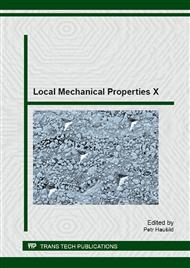p.183
p.187
p.191
p.197
p.201
p.205
p.209
p.213
p.217
Mechanical Properties of Nanotextiles Determined with Digital Image Correlation
Abstract:
The paper is devoted to the assessment of mechanical properties of nanotextiles prepared from polyvinylalcohol by electrospinning. The nanotextile is composed of a multi-layered net of cross-linked fibers with individual diameters of approx. 200-500 nm. Strips of the textiles were tested in a standard electromechanical testing device by uniaxial tension. Precise local strain measurement was provided by the digital image correlation method. The overall nanotextile Young's modulus was found to be 277±9 MPa (for strains <1%) and exhibited small variations as well as ultimate strength (10.3±0.9 MPa at ~13% strain). The deformation mechanism includes alignment and stretching of the fibers in longitudinal (load) direction (initial linear part), yielding with transversal textile smoothing and textile rupture (at strains ~13%). The progress of apparent Poisson's ratio (5.5-0.52) was also monitored with the digital image correlation.
Info:
Periodical:
Pages:
201-204
Citation:
Online since:
March 2014
Authors:
Price:
Сopyright:
© 2014 Trans Tech Publications Ltd. All Rights Reserved
Share:
Citation:


